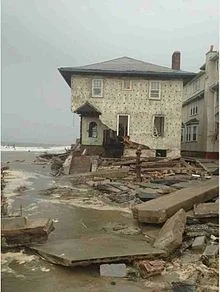We seek out wet and expensive places
Damage from Superstorm Sandy in Brooklyn on Oct. 29, 2012.
From Robert Whitcomb's "Digital Diary,'' in GoLocal24.com:
The Coast Guard does a terrific job in protecting Americans from storms, drug smugglers and other perils. The recent rash of hurricanes has provided more reminders of that. But the Trump administration has proposed cutting funding for the service by 2.4 percent.
That comes as the Coast Guard has been spending millions on protecting Donald Trump’s for-profit Mar-a-Lago club in Palm Beach, Fla. It spent $6.6 million just on six presidential weekend trips last spring! By the way, after Donald Trump was elected, the club jacked up its initiation fee to $200,000. But anything to be a jet-setter and make some more money for our monarchical First Family.
Meanwhile, let’s watch how rising sea levels and more coastal flooding might affect the Coast Guard’ s mission and activities.
President Trump has called globalwarming a hoax but on that issue and most others, he turns out to have no fixed positions. He just takes whatever position seems the best political sale at the time, especially to his base.
He announced in June that the U.S. would leave the Paris Climate Accord. But now, says Secretary of State Rex Tillerson, we might stay in it after all. Tillerson said last Sunday: “The president said he is open to finding those conditions where we can remain engaged with others on what we all agree is a challenging issue.’’ Eh?
Tillerson said that Gary Cohn, Trump’s top economic adviser, was overseeing the issue. Why him?
“So I think the plan is for director Cohn to consider other ways in which we can work with partners in the Paris Climate Accord. We want to be productive. We want to be helpful,” said Tillerson. Translation, please.
Would a couple of bad hurricanes hitting the U.S. mainland in the past few weeks have anything to do with this apparent change? Trump is media-obsessed and the Irma and Harvey damage photos weren’t particularly good optics for global-warming skeptics.
So perhaps the president can be persuaded to rescind his reversal ofan Obama executive order that had required the Feds to consider climate change and accompanying sea-level rise when building/rebuilding such public infrastructure as highways, bridges and levees – an order that some seaside developers have sought to quash because it might ultimately depress real-estate sales on properties that shouldn't be built on.
Some of the challenge of addressing global warming can been seen in a couple of statistics: The population of U.S. coastal counties has grown 5.6 percent since 2010 while that of inland counties rose just 4 percent. People love to be near water, but they don’t want to think about the fact that they or at least their seaside property could end up underwater.
There’s the threat of rising seas to life and property on irresponsibly developed coastal strips. But poorly regulated coastal development also destroys such natural barriers to flood disasters as marshes, which are also essential places for the life cycles of fish and other wildlife. The sort of virtually uncontrolled seaside development we’ve seen poses very broad ecological threats.
